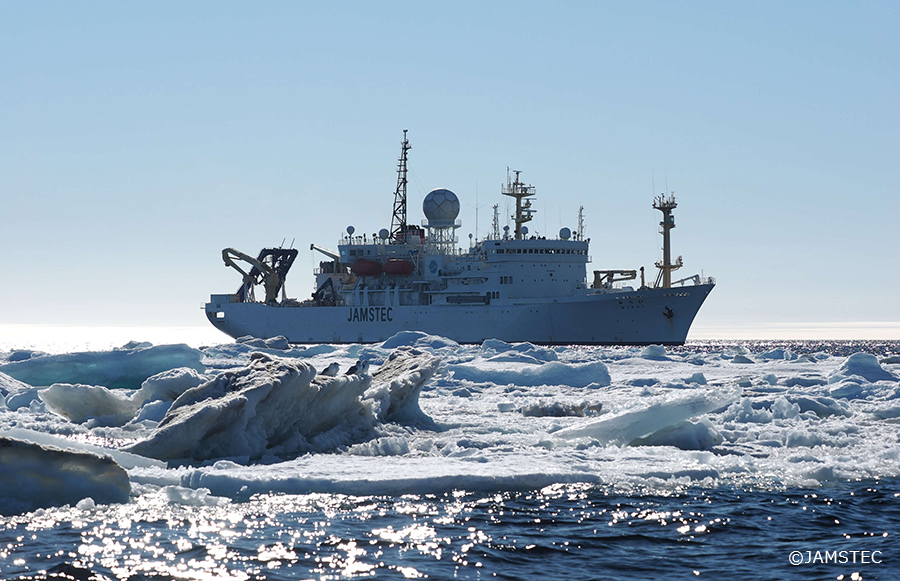Arctic Ocean Observation and International Collaboration
July 1, 2022
Takashi KIKUCHI,
Director, Inst. Arctic Climate and Environment Res., Research Inst.
Global Change/Group Leader,
International Observation Planning Group,
Project Office for Arctic Research Vessel (PARV)

Some of the environmental changes occurring in and around the Arctic Ocean are manifestations of disasters and changes associated with the fast warming on Earth. Examples include increased storm damage from waves, storm surges and coastal erosion, ocean acidification, and ecosystem changes. It is also becoming widely understood that these effects are not just limited to the Arctic; they extend to the rest of the planet as well. These environmental changes in the Arctic Ocean and their impacts, need to be clarified and the data and findings made publicly available so they can be accessible and used in global environmental research and societal improvement. To get these data and samples, we need to go to the Arctic Ocean and conduct in-situ observations. The Arctic Ocean is like a frozen Mediterranean Sea surrounded by these coastal states; the United States, Canada, Denmark (Greenland), Norway, and Russia. The central part of the Arctic Ocean is in international waters, but the exclusive economic zones of each border country extend from the coast towards the center. In addition, although the ice-free areas of the Arctic have increased during late summer and early fall due to the warming climate, sea ice still covers much of the Arctic Ocean, making it difficult to conduct in-situ observations. This makes research collaboration with the Arctic states and other countries essential for research in the Arctic Ocean. Thus, international collaboration here is even more important than in other oceans.
There are several types of international collaboration. For example, these can be divided into bilateral and multilateral collaborations. Bilateral international collaborations are implemented through agreements or arrangements between researchers and institutions in the party and the partner country, or at the governmental level. JAMSTEC has concluded memorandums of understanding (MOU) with 21 overseas institutions to promote international cooperation, and international joint research between institutions is being conducted in accordance with these agreements. The agreement includes joint research and development on the Arctic with eight organizations, including the U.S. National Oceanic and Atmospheric Administration (NOAA), the University of Alaska Fairbanks (UAF), Woods Hole Oceanographic Institution, the Institute of Marine Research (Norway), the University of Bergen (Norway), the University of Tromsø (Norway), the Canadian Department of Fisheries and Oceans (DFO), and the Alfred Wegener Institute (Germany). Under these MOU, we have been conducting various joint observations and research and published their results. Collaborations with Arctic coastal countries are especially important for conducting in-situ observations in the Arctic Ocean. JAMSTEC has been conducting observations in the Pacific sector of the Arctic Ocean using Research Vessel "Mirai" (R/V Mirai) and has been collaborating with NOAA, the International Arctic Research Center (IARC) at the UAF and the Institute of Ocean Sciences (IOS) of the DFO to share procedures and information necessary for observations along the coast of the United States (Alaska) and Canada. Cooperation with local research institutions is very important, not only for research activities but also for the procedures and tasks necessary to carry out observations and to coordinate with the local community.
Multilateral international collaborations can be implemented as short-term international projects or as activities promoted by international organizations over the medium to long term. There have been several international projects on Arctic Ocean observation. For example, the International Polar Year (2007-2009) was an international scientific project covering both poles, co-sponsored by the International Council for Science (ICSU) and the World Meteorological Organization (WMO). Many countries participated, and observations and research on the Arctic and Antarctic were conducted not only in the natural sciences, but also in ecology, human and social sciences, economics, and other fields. As for Arctic Ocean observations, each country conducted vigorous observations during the IPY period, and the data and results were made public. Recently, the international observation project MOSAiC (Multidisciplinary drifting Observatory for the Study of Arctic Climate), in which the German icebreaker Polarstern was used as a year-round ice-drifting station in the Arctic Ocean, was conducted between September 2019 and October 2020. The MOSAiC project was led by Germany, and a total of 442 researchers from 20 countries participated in the project, obtaining unprecedentedly valuable and interdisciplinary data in the Arctic Ocean. From Japan, researchers from the National Institute of Polar Research, Hokkaido University, the University of Tokyo, and other institutions are participating in this project. In addition, the Synoptic Arctic Survey (SAS) was conducted from 2020 to 2022, in which many research institutes collaborated to conduct simultaneous observations covering a wide area of the Arctic Ocean. JAMSTEC is one of the leading institutions and conducts R/V Mirai observation in the Pacific sector of the Arctic Ocean under the SAS project.

Working through international organizations is also one way of international cooperation. There are two types of organizations, one for academic research purposes led by researchers and the other composed of national governments, each with a different role to play. The International Arctic Science Committee (IASC) plays the most central role in Arctic research as an academic organization. IASC promotes and supports cutting-edge interdisciplinary research aimed at a more scientific understanding of the Arctic and its role in the Earth system. Currently, 24 countries are members. The Arctic Council (AC) is the leading intergovernmental forum consisted of eight Arctic States, six permanent participants that are indigenous peoples' organizations, and 38 observers (Non-Arctic Countries and NGOs). AC promotes cooperation on common issues such as sustainable development and environmental protection in the Arctic. In addition, there are many other conferences, organizations, and programs related to Arctic research that are linked to international research activities and are working toward their own purposes and goals. These organizations and their various activities will be introduced in upcoming posts.
Reference:
MOSAiC (Multidisciplinary drifting Observatory for the Study of Arctic Climate)
SAS (Synoptic Arctic Survey)
IASC (International Arctic Science Committee)
AC (Arctic Council)

